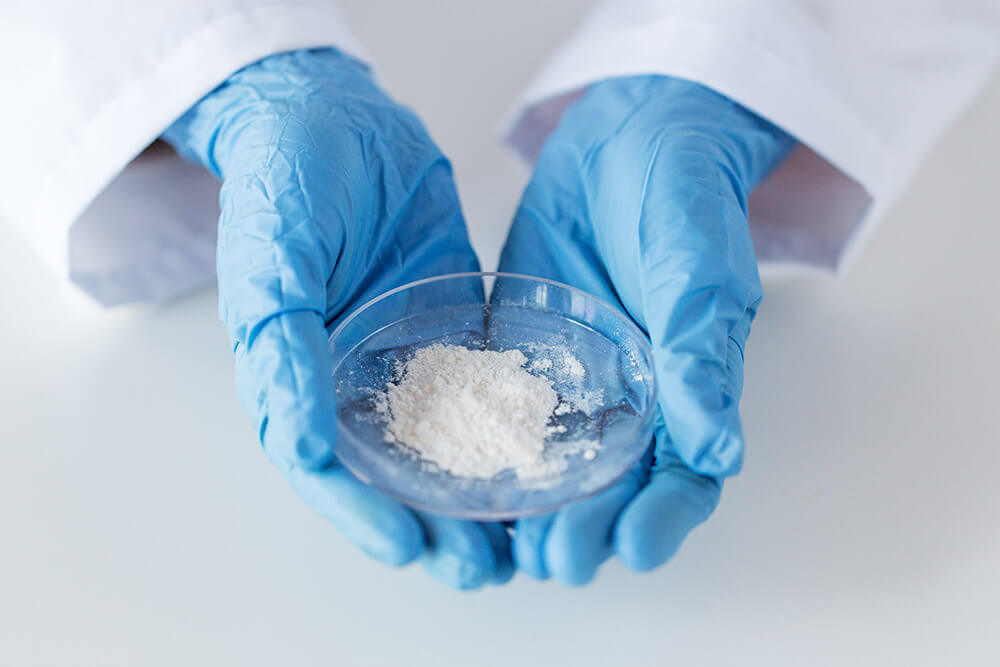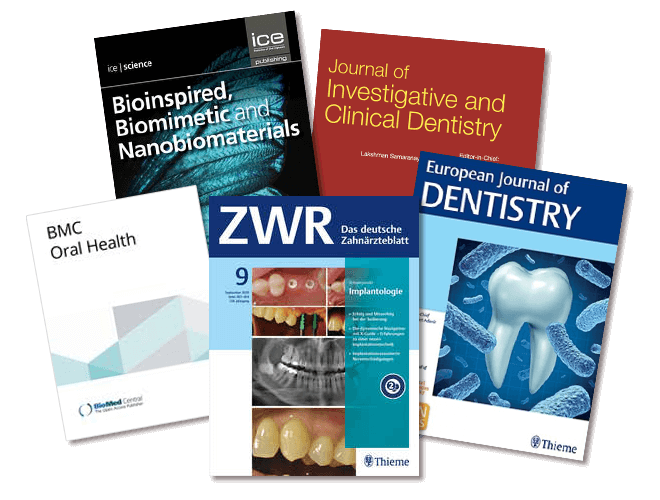Innovation and research
Oral diseases, such as caries, have been in decline in the past few years. This positive development is particularly due to the great commitment of dentists and the whole team to provide information to their patients and the offer of professional cleaning and prophylaxis programmes.
Nevertheless, 99% of adults and approx. 50% of children with milk teeth have had experience with caries (Meyer & Enax 2018). Normal oral care products are reaching their limit.Further research and innovative active substances are needed to reduce caries further.
Find out here about the dental care innovations developed by Dr. Wolff and how the novel active substance “BioHAP” protects your teeth. You can also explore Dr. Wolff Research partners on our map.
Innovative concepts for oral care
Our teeth are made up of 97% hydroxyapatite and are considered the hardest substance in the human body. Hydroxyapatite is a natural crystalline substance. Its special crystal structure is responsible for the high fracture strength of the teeth.
However, it becomes problematic for the teeth when they are attacked by acids. Acids are produced by numerous microorganisms in the oral cavity and they attack the enamel. Teeth can be repaired (“remineralisation”) with a balanced diet and normal saliva flow. This is mainly due to a number of components in our saliva, which acts as an acid buffer. A diet rich in carbohydrates and sugars or possible salivary gland disorders result in demineralisation, which is initially accompanied by initial caries.
To prevent caries and other acid-related damage (erosion), teeth must be protected, plaque formation must be reduced and salivary flow must be stimulated. The active substance BioHAP (biomimetic hydroxyapatite) can offer optimum help here. This substance is modelled on natural enamel and builds up on the surface of the tooth, therefore offering a remedy for acid-related dissolution. The novel mode of action has many more advantages for our dental health:
- BioHAP forms a protective layer on the teeth that protects them from acid attacks.
- BioHAP reduces the adhesion of bacteria to the surface of the tooth and therefore reduces the formation of dental plaque.
- BioHAP releases calcium to counter bacterial acid attacks. It thus protects the tooth against demineralisation.
- BioHAP repairs the enamel (remineralisation) and thus prevents caries.
- BioHAP builds up on the tooth and leaves the teeth looking brighter.
Research at Dr. Wolff
Research at Dr. Wolff has been of central importance since the company was founded in 1905. Research into innovations for dental care is “made in Germany” at the Bielefeld-based company and in renowned national and international collaborations with independent institutes, university hospitals and dental practices.
Discover the Dr. Wolff network
Click on the links to find out more about the individual research collaborations
International research collaborations
Bielefeld
Dental practice of Dr Kai Zwanzig, Bielefeld
Daily dental care with HAP toothpastes prevents sensitive teeth.
Steinert, S. et al. Daily application of a toothpaste with biomimetic hydroxyapatite and its subjective impact on dentin hypersensitivity, tooth smoothness, tooth whitening, gum bleeding, and feeling of freshness. Biomimetics 5, 17 (2020).
Read studyHAP gel brightens teeth when used daily.
Steinert, S. et al. Whitening effects of a novel oral care gel with biomimetic hydroxyapatite: A 4-week observational pilot study. Biomimetics 5, 65 (2020).
Read studyReview on the prevention of inflammatory diseases with implants.
Steinert, S., Enax, J., Simader, B., Zwanzig, K. & Meyer, F. Prävention der periimplantären Mukositis. Dentale Implantologie 5, 272-275 (2020).
Read studyBraunschweig
Braunschweig Department of Health
In vivo study: gel with HAP works as a source of calcium.
Sudradjat, H., Meyer, F., Loza, K., Epple, M., Enax, J. In vivo effects of a hydroxyapatite-based oral care gel on the calcium and phosphorus levels of dental plaque. Eur. J. Dent. (2020).
Read studyBerlin
Charité Berlin
In vitro study shows: HAP remineralises dentine and enamel.
Tschoppe, P., Zandim, D. L., Martus, P. & Kielbassa, A. M. Enamel and dentine remineralization by nano-hydroxyapatite toothpastes. J. Dent. 39, 430-437 (2011).
Read studyHalle/Saale
Fraunhofer Institute Halle/Saale
HAP builds up on the teeth and makes them brighter.
Sarembe, S., Enax, J., Morawietz, M., Kiesow, A. & Meyer, F. In vitro whitening effect of a hydroxyapatite-based oral care gel. Eur. J. Dent. 14, 335-341 (2020).
Read studyDresden
University Hospital of Dresden
In situ study confirms: the active substance HAP prevents the formation of biofilm on our teeth.
Kensche, A. et al. Efficacy of a mouthrinse based on hydroxyapatite to reduce initial bacterial colonisation in situ. Arch. Oral Biol. 80, 18-26 (2017).
Read studyFrankfurt am Main
Multicentre study with the University Hospitals of Dresden, Frankfurt, Regensburg, Munich and Würzburg
Multicentre clinical study: HAP is effective in preventing caries.
Schlagenhauf, U. et al. Impact of a non-fluoridated microcrystalline hydroxyapatite dentifrice on enamel caries progression in highly caries-susceptible orthodontic patients: A randomized, controlled 6-month trial. J. Invest. Clin. Dent., (2019).
Read studyHomburg
Saarland University Hospital
Mouthwash with HAP reduces the formation of biofilm on the teeth in situ.
Hannig, C., Basche, S., Burghardt, T., Al-Ahmad, A. & Hannig, M. Influence of a mouthwash containing hydroxyapatite microclusters on bacterial adherence in situ. Clin. Oral Investig. 17, 805-814 (2013).
Read studyWürzburg
University Hospital of Münster and University Hospital of Würzburg
Multicentre clinical study: HAP toothpaste improves gum health.
Harks, I. et al. Impact of the daily use of a microcrystal hydroxyapatite dentifrice on de novo plaque formation and clinical/microbiological parameters of periodontal health. A randomized trial. PloS one 11, (2016).
Read studyRegensburg
University Hospital of Regensburg
Topic of “sensitive teeth”
In vitro study by the University Hospital of Regensburg shows occlusion of dentinal tubules with HAP.
Hiller, K.-A., Buchalla, W., Grillmeier, I., Neubauer, C. & Schmalz, G. In vitro effects of hydroxyapatite containing toothpastes on dentin permeability after multiple applications and ageing. Sci. Rep. 8, 4888 (2018).
Read studyTopic of “Mode of action of hydroxyapatite”
HAP acts as an acid buffer and source of calcium.
Cieplik, F. et al. Ca2+ release and buffering effects of synthetic hydroxyapatite following bacterial acid challenge. BMC Oral Health 20, 85 (2020).
Read studyTopic of “New active substances”
Natural citrus extract has antibacterial effect on oral biofilms.
Cieplik et al. Antimicrobial efficacy of alternative compounds for use in oral care toward biofilms from caries‐associated bacteria in vitro, Microbiology Open, 8, 4 (2018).
Read studyMulticentre study with the University Hospitals of Dresden, Frankfurt, Regensburg, Munich and Würzburg
Multicentre clinical study: HAP is effective in preventing caries.
Schlagenhauf, U. et al. Impact of a non-fluoridated microcrystalline hydroxyapatite dentifrice on enamel caries progression in highly caries-susceptible orthodontic patients: A randomized, controlled 6-month trial. J. Invest. Clin. Dent., (2019).
Read studyMunich
Multicentre study with the University Hospitals of Dresden, Frankfurt, Regensburg, Munich and Würzburg
Multicentre clinical study: HAP is effective in preventing caries.
Schlagenhauf, U. et al. Impact of a non-fluoridated microcrystalline hydroxyapatite dentifrice on enamel caries progression in highly caries-susceptible orthodontic patients: A randomized, controlled 6-month trial. J. Invest. Clin. Dent., (2019).
Read studyMünster
University Hospital of Münster and University Hospital of Würzburg
Multicentre clinical study: HAP toothpaste improves gum health.
Harks, I. et al. Impact of the daily use of a microcrystal hydroxyapatite dentifrice on de novo plaque formation and clinical/microbiological parameters of periodontal health. A randomized trial. PloS one 11, (2016).
Read studyEssen
University of Duisburg-Essen
Review on modern dental care.
Epple, M. & Enax, J. Moderne Zahnpflege aus chemischer Sicht. Chem. Unserer Zeit 52, 218-228 (2018). [English translation: Epple, M. & Enax, J. The chemistry of dental care (Parts 1-3). ChemViews Mag. (2018).]
Read studyReview-article on abrasives used in oral care
Enax J. & Epple, M. Die Charakterisierung von Putzkörpern in Zahnpasten. Dtsch. Zahnärztl. Z. 73, 116-124, (2018).
Read studyDüsseldorf
Max Planck Institute Düsseldorf
HAP builds up on the tooth and forms a protective layer.
Fabritius-Vilpoux, K., Enax, J., Herbig, M., Raabe, D. & Fabritius, H.-O. Quantitative Affinity Parameters of Synthetic Hydroxyapatite and Enamel Surfaces in vitro. Bioinspir. Biomim. Nan. 8, 141-153 (2019).
Read studyU.S.A.
Renowned cariologist Prof B.T. Amaechi and colleagues at the UT Health San Antonio, Texas, USA
HAP gel is just as effective at remineralisation as a highly concentrated fluoride gel.
Amaechi, B. T. et akl. Comparison of hydroxyapatite and fluoride oral care gels for remineralization of initial caries: a pH-cycling study. BDJ Open 6, 9 (2020).
Read studyToothpaste with HAP remineralises caries deep down
Amaechi, B. T. et al. Comparative efficacy of a hydroxyapatite and a fluoride toothpaste for prevention and remineralization of dental caries in children. BDJ Open 5, 18 (2019).
Read studyThe Netherlands
Dentist Dr Barbara Simader, the Netherlands
Review on the prevention of inflammatory diseases with implants.
Steinert, S., Enax, J., Simader, B., Zwanzig, K. & Meyer, F. Prävention der periimplantären Mukositis. Dentale Implantologie 5, 272-275 (2020).
Read studyReview on active substances in toothpastes and mouthwashes.
Meyer, F., Enax, J. & Simader, B. Können wir dank Mundspülungen auf das Zähneputzen verzichten? Dental Tribune 6, 18-19 (2019).
Read studyPoland
Polish research team with American and German partners
One-year multicentre clinical study confirms: Children’s toothpaste with BioHAP is just as effective at protecting against caries as a fluoride toothpaste.
Steinert, S., Enax, J., Simader, B., Zwanzig, K. & Meyer, F. Prävention der periimplantären Mukositis. Dentale Implantologie 5, 272-275 (2020).
Read studyNumerous national and international scientific publications have proven the efficacy of BioHAP in dental care and prophylaxis:
- A toothpaste with BioHAP is just as effective at protecting against caries as a toothpaste with anime fluoride and stannous fluoride.
- BioHAP is highly effective in controlling the biofilm and does not affect the ecological balance. BioHAP is antimicrobial, but keeps the microbial equilibrium.
- BioHAP is a calcium-source to protect our teeth and also ensures that the acids from caries bacteria are weakened.
- A gel with BioHAP is just as effective as a highly concentrated fluoride gel in remineralising caries.
- A gel with BioHAP results in brighter teeth, while also being gentle on the teeth.
In addition to laboratory studies (in vitro), studies with test specimens under oral cavity conditions (in situ) as well as clinical studies on patients (in vivo) have been conducted.
You can find further publications in our study database.
A voyage into the interior of our teeth
An atlas of the fine structure of our teeth
The book shows the minute construction of teeth as seen in numerous images made with a scanning electron microscope (SEM) of their various structures. This illustrated book is subdivided into several thematically defined chapters, presenting SEM images of the enamel and dentin of permanent teeth and primary teeth. The effects of caries and erosion are also vividly presented. The images have such a high magnification – up to one ten-millionth of a millimetre – that even individual hydroxyapatite crystallites of the enamel become visible. Have a look here in the illustrated book.
If you are interested in the illustrated book and/ or in any of the digital teaching material based on it, please contact kw-oralcare@drwolffgroup.com, indicating your name and address.
This might also interest you:

Studies and scientific information






